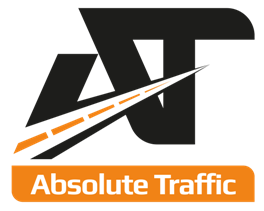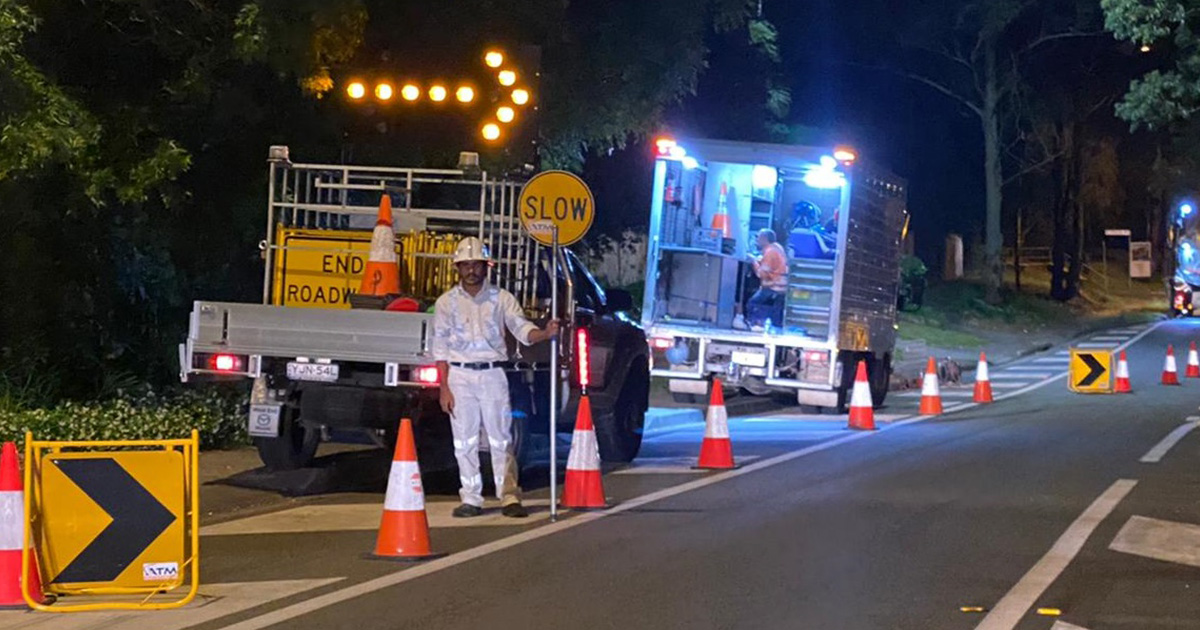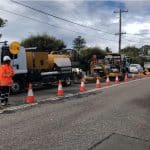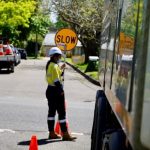Working in proximity to traffic is particularly dangerous due to traffic hazards. In 2019, 183 workers were fatally injured at work. So, what is a traffic hazard? Or, what is considered a roadside hazard? And, how can we prevent road hazards?
Today, April 28th, is World Day for Safety and Health at Work and Workers’ Memorial Day. In a few weeks, from May 16th to 23rd, it will be National Road Safety Week. So, the team at Absolute Traffic Management thought it was important to share advice on how to assess traffic hazards at construction sites next to roads.
A Definition of Traffic Hazard
In short, hazard means a situation or thing that has the potential to harm a person. To illustrate, a ‘traffic hazard’ generally occurs when an incident happens between vehicles and pedestrians. In other words, they can be associated with roads, traffic, vehicles, weather, and work activities.
On the one hand, employers, supervisors and prime contractors need to identify potential hazards when working in proximity to traffic. They, they need to use the hierarchy of controls to put the appropriate level of controls in place to protect workers from those hazards. On the other hand, they need to ensure workers know the hazards and how to protect themselves.
Above all, at Absolute Traffic Management, keeping our employees, other workers and the public safe from traffic hazards is a priority for us. In this article, we’ll see how employers and supervisors can prepare to work at the roadside, and what the requirements are. Then, we’ll see what workers need to know and do, and important things to do. Finally, we’ll share the hazard identification checklist for employers and supervisors.
Get Ready To Work At The Roadside
Work at the roadside is a hazardous work area. To explain, Road Traffic Act 1961 (SA), section 20, defines a hazardous work area:
(a) where—
i. Workers may be working on a part of a carriageway for vehicles proceeding in a particular direction and there is no adjoining marked lane outside the work area for vehicles proceeding in the same direction; or
ii. They may be working less than 1.5 metres from vehicles proceeding on a carriageway, and the work is carried out on foot and not exclusively through the use of vehicles;
(b) Or, where an unusually high level of hazard for workers or persons using the road is created as a consequence of the existence of the work area.
First of all, if there is a prime contractor, as an employer or supervisor, you should determine a scope of work. And, it should include identification of hazards and their risks for roadside workers. Then, implement a system for the identification, assessment and recording of reasonably foreseeable hazards. And, evaluate the probability and consequences of injury or illness arising from exposure to an identified hazard.
Then, check if this contractor has coordinated the identified controls for these risks with the firm providing traffic control. In addition, make a hazard assessment of the work zone and communicate it to all workers on-site. Finally, make sure you’re up-to-date with any required regulations to determine the requirements of the work zone.
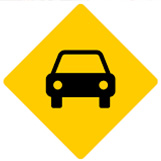
Check The Requirements And Avoid Traffic Hazards
Next, before working in proximity to traffic, check the requirement to create a safe work zone. Especially, as an employer or supervisor, make sure you have:
- First, a documented layout that includes the site-specific hazards, if necessary.
- Second, the temporary traffic control devices (such as barriers, cones, signs) the site will require.
- Third, safe work procedures, regarding the communication between workers, and the work around mobile equipment and vehicles.
- Then, an emergency plan. An emergency plan is a written set of instructions that outlines what workers and others at the workplace should do in an emergency.
- Also, each of your workers equipped with high-visibility clothing and all other required personal protective equipment (PPE).
- And, verified the adequate and required training and shared a safety briefing with all workers.

Inform Roadside Workers of Traffic Hazards
In addition, employers and supervisors have to make sure their workers understand:
- First, the work zone layout, that addresses the site-specific hazards. It is essential to set up the work zone properly to make sure workers, motorists, cyclists, and pedestrians are safe. Ensure that there is a traffic control plan for it.
- Second, hazards of the work zone, including mobile equipment or work vehicles.
- Third, Safe work procedures for roadside work, working around mobile equipment and work vehicles.
- Also, communication procedures in the work zone. The ability to communicate effectively in the building and construction industry is essential. That is why, workers need to understand how to participate in routine communication in the workplace, and how to recognise written and visual communication common to the building and construction industry.
- And, emergency procedures. Share with them the emergency plan for the work site.
How to report near misses and other safety incidents.
So that the workers:
- First, stock their utes with signs, cones, and other traffic control devices.
- Second, know how to set up a safe work zone: i.e. how to place traffic warning signs.
- Third, know how to identify and address traffic hazards once they arrive at their work site.
Consequently, if you’re a manager, discuss with your workers, or involve risk analysis tools and techniques.
Check Everyone’s Role And Ensure Proper Set-Up
- To do so, identify a person responsible for the work zone set-up.
- And, make sure the traffic controllers have the proper training and carry proof of it. Ensure that the organisation’s training systems identify and record that workers have undertaken the required training. And, that they carry on their person a current card (white card, etc.)
- In addition, ensure workers always stand in a safe position.
- Moreover, identify hazards and controlled risks associated with job activities, in addition to vehicle and traffic hazards. In other words, identify anything that may cause injury or harm to the health of a person. To do so, identify all machinery and plant the workplace use and identify the sources of hazards. Then, assess the risk arising from the hazards. And, decide on the use of appropriate controls.
Furthermore, have a plan to regularly inspect the work zone to ensure proper set-up. In particular, ensure that appropriate controls for all identified hazards are implemented.
The following checklist detailed below can help identify traffic hazards specific to your workplace.

Use A Hazard Identification Checklist
At your work zone, fill in the hazard identification checklist before work begins. And, use the checklist is a general guideline when working in proximity to traffic. However, although it includes potential hazards it is not an exhaustive list.
In addition, list any other hazards that are present in your work zone. And, both the employer and prime contractor should complete the checklist. For each of the following actions, select “yes/no/NA”, write the date and comments.
Floor Plan
– First, have you checked the plan?
– Second, have you walked the layout of the plan?
– Third, do you have copies or sketches of the plan?
– Finally, are there any identified ‘short cuts’?
Traffic management problems faced on the worksite
Have you asked the following persons about the problems they face?
– Your employees
– Other onsite workers
– Pedestrians
– Visiting drivers
– Has there been any incidents and injuries reported (including near misses) for you to read?
– Are there any video footage to help identify areas where traffic hazards could occur?
– What types of vehicles use the same areas as pedestrians?
– How do pedestrians, workers, and vehicles move around the worksite?
-
– Are there separate areas for each?
– Different routes for each to take?
– Are there signs and directions given?
– Are there physical barriers in use?
– Can everyone see and hear everyone?
– How do vehicles ‘line up’ (aka queue)?
– Could this cause a risk?
– Has it caused a risk previously?
– Are crossing or road safe markings obstructed?
– Is line-of-sight blocked? (can everyone see everyone)
– How wide are the lanes / routes?
- – Is there safe distance between vehicles and pedestrians?
– When, where and how often do vehicles and pedestrians interact?
- – Can this be changed? (ie – change in scheduled times and routes?)
– Is work being done near public areas?
– When is peak hour for vehicles and pedestrians?
(ie – are there times when there is more movement happening on the worksite?)
– What locations are considered risk locations?
Consider:
– Where traffic might become congested
– Any blind spots or where line-of-sight might be compromised
– Previous incident locations
– Where vehicles and pedestrians are in close proximity (share same route)
– Can workers/visitors perform tasks (ie maintenance; loading and unloading; and regularly stopping activities) safety from traffic?
– Are there any stationary objects causing a risk or a safety concern?
Here, consider:
– First, is contact possible?
– Second, any blind spots?
– Third, any previous incidents?
– Can you think of any other hazards that could cause a risk?
Consider:
Concerns with noise, air, visibility, falling objects, etc
– Does the worksite impact on health and safety?
Consider:
– Route, path, and road conditions
– Weather conditions
– Lighting conditions
– Temperatures during the day
– Can vehicles and pedestrians take short cuts?
– Are contractors and new employees inducted and supervised?
– Are employees and other workers aware of hazards and the actions being taken to manage them?
Traffic Hazards: Further Information
Finally, you can find the Codes of practice, guidance material and other resources on the Safe Work Australia website. There, you will have access to the Safe Work Australia’s Traffic Hazard Checklist.
To conclude, let’s take action to eliminate or at least, minimise health and safety risks due to traffic hazard at work. To do so, we need to anticipate, prepare and respond to crises. So, this means undertaking risk management that is planned. And, covers all reasonably foreseeable hazards and associated risks.
In short, Health and Safety is a fundamental workers’ right’. That’s why, Safe Work Australia encourages everyone to raise awareness about health and safety in the workplace. So, if you have any concern about your safety at work due to traffic hazard, don’t hesitate to contact us!
